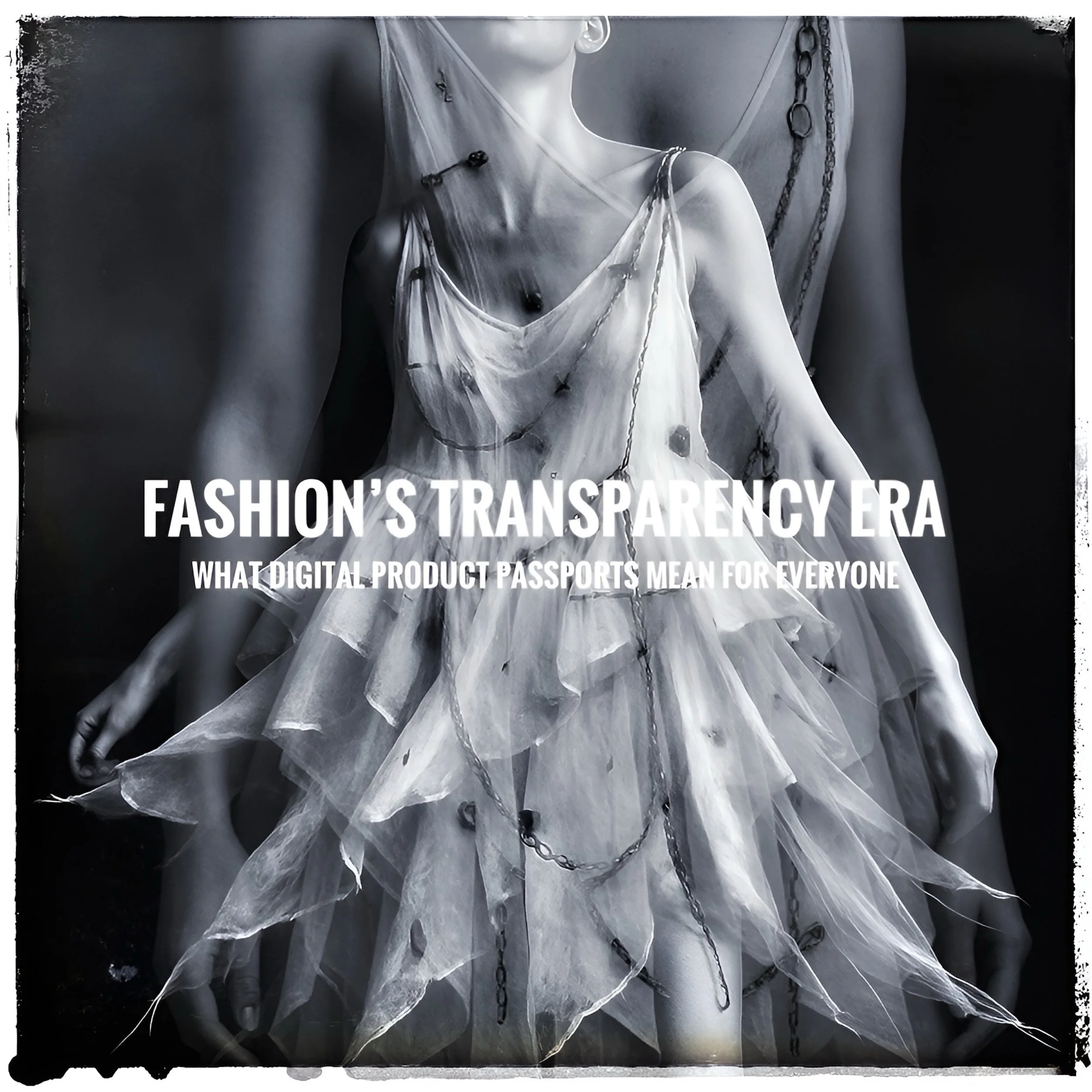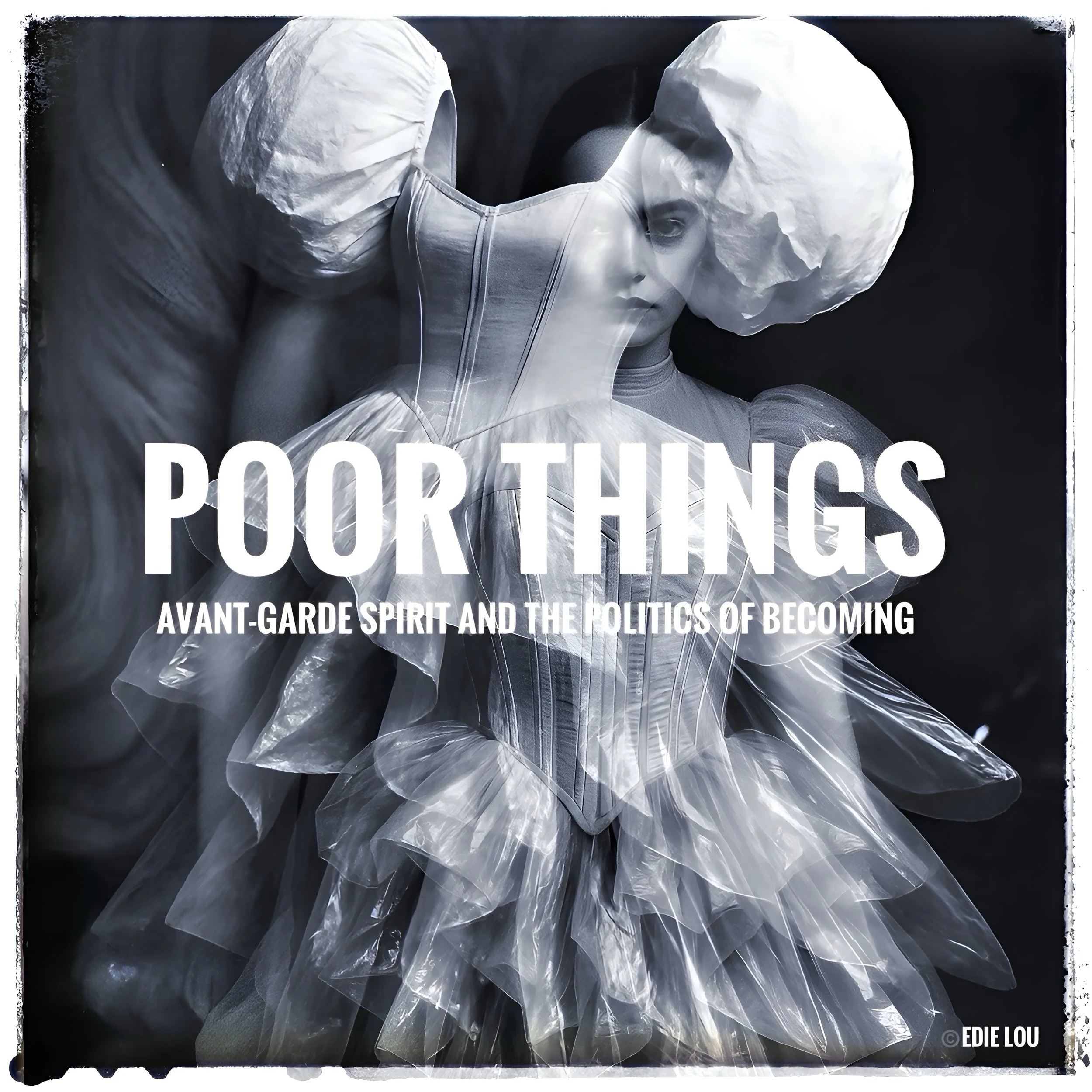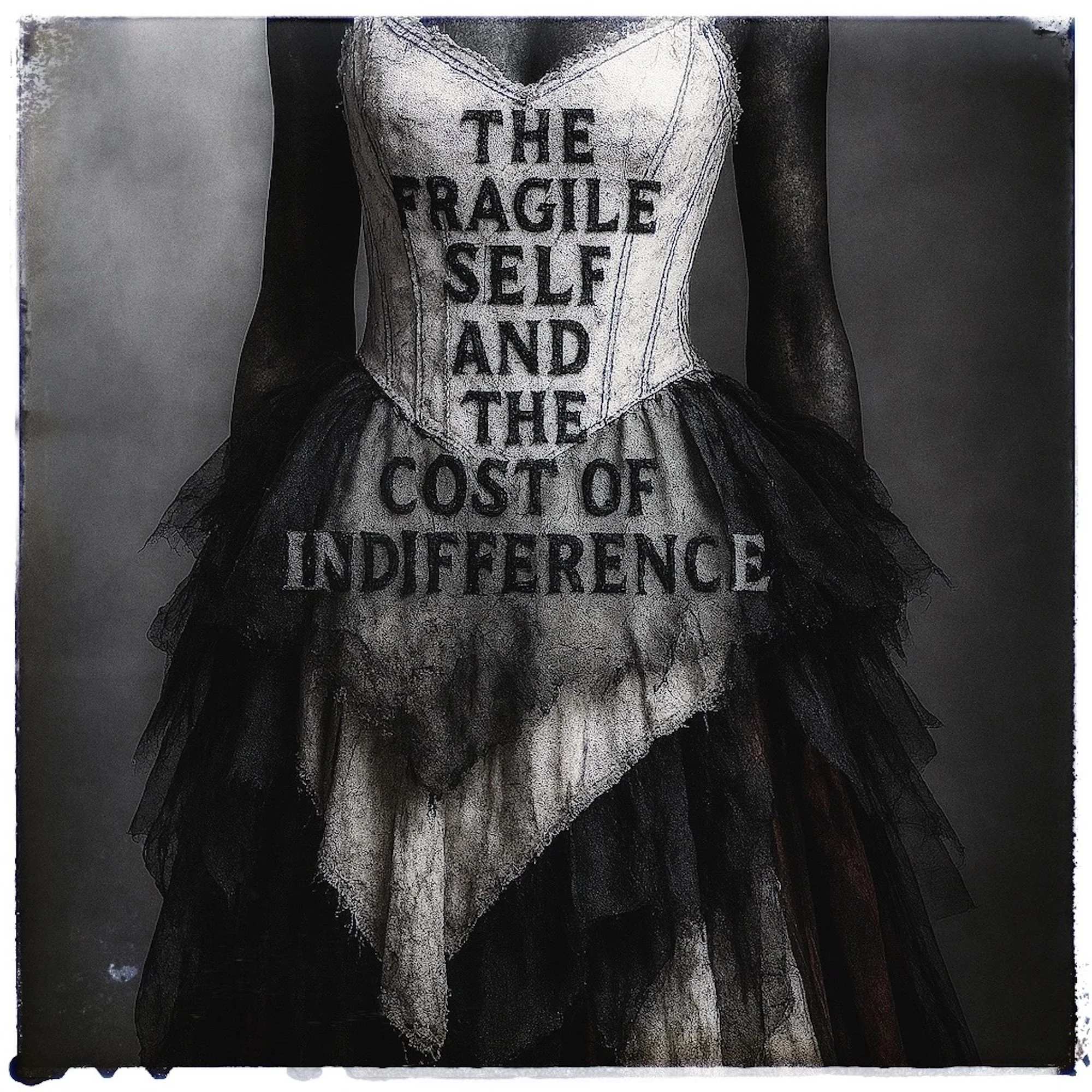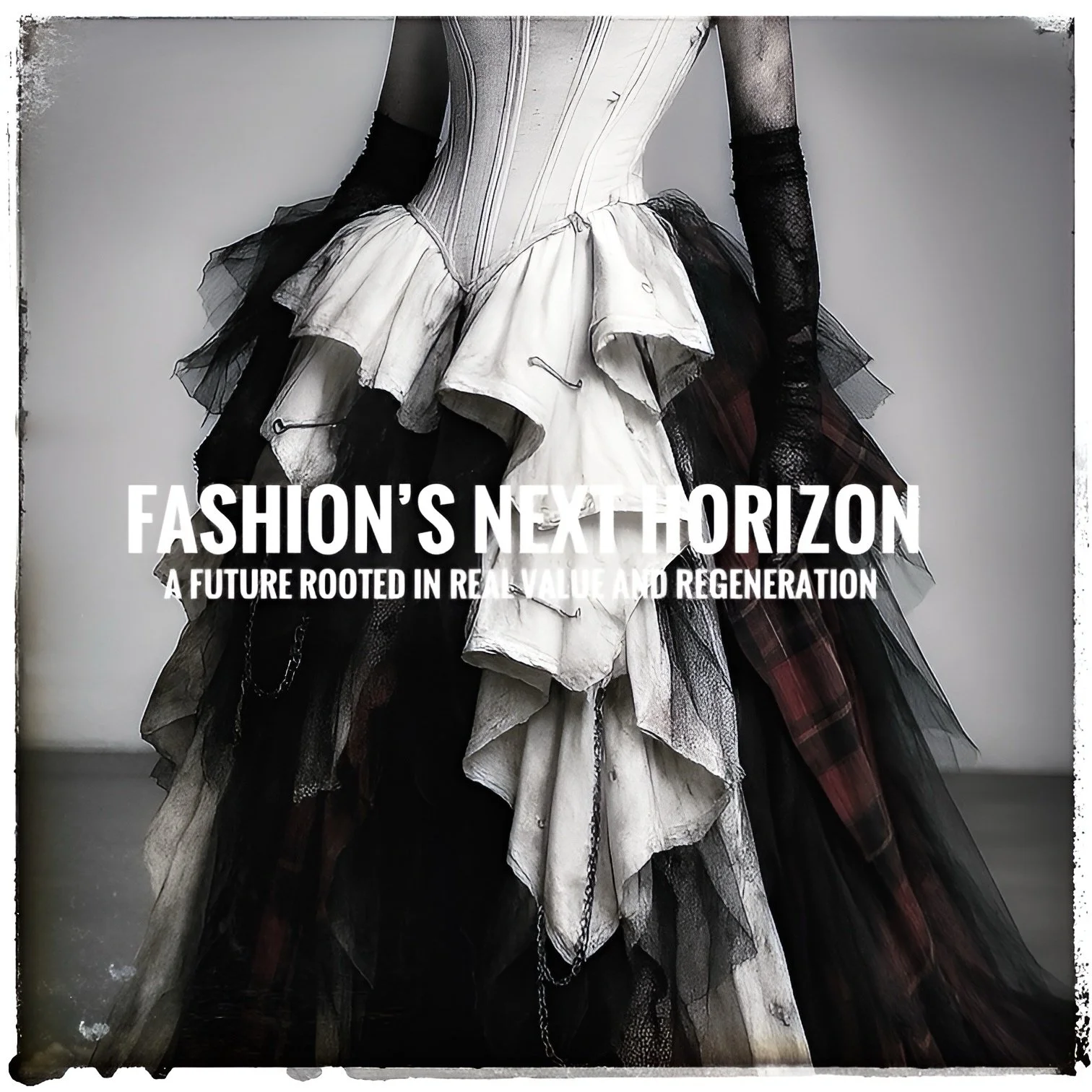pulp.
paper unites labyrinthine people.
PULP is the editorial voice of ELS - where fashion, culture and sustainability collide with curiosity and openness. It is a space for fresh ideas and thoughtful conversations, exploring the evolving landscape of conscious design and the dynamics of cultural issues.
We are here to question, reflect, and discover what the future can look like - whether through new materials or shifts in the industry and in society. PULP is a place to connect, grow, and be a part of the cultural zeitgeist, where inclusivity and diversity are at the heart of the conversation, as we collectively shape a more thoughtful, equitable future.

from design to distribution: a strategic overview of the fashion industry
This article offers a structural overview of the contemporary fashion system, tracing how garments move from initial design through sourcing, manufacturing, distribution, and retail. It examines the chain of decisions made along the way - how materials are selected, how production is managed, how logistics shape margins, and how retail environments convert presence into demand. The goal is to clarify how each stage contributes to economic performance and material outcomes, and how inefficiencies or misalignments accumulate into financial loss and waste.
Alongside the dominant model - built around long lead times, seasonal calendars, and volume-based production - the piece also maps emerging alternatives: direct-to-customer strategies, made-to-order systems, and surplus-based sourcing. These models operate on different assumptions and timeframes, offering varied approaches to aligning production with demand, material limits, and cultural shifts. This structural overview aims to make visible the operational choices available to both established players and independent designers, and to map out how the system works. The older model - based on seasonal planning, long lead times, and large production volumes - is clearly unsustainable - ecologically, socially, and economically. It has led to chronic overproduction, markdown cycles, and enormous waste. Yet it persists because it is deeply embedded in supply chains, business structures, and retail expectations. At the same time, emerging alternatives are proving viable, especially for smaller, more agile brands. These models - DTC and MTO or local production - offer clearer alignment between demand and production, between values and operations.

inside the framework - the personal layer of ELS upcoming collection
This week on PULP focuses on the written layer of Stardust Dignity, the upcoming collection by Edie Lou Studio. While the previous collection, the (Birth) Right Cut, translated the Universal Declaration of Human Rights into printed form, this one turns inward - the words are personal. They feature raw, unfiltered texts written over the past nine years - during my time living in California, Paris, Florence, and Zurich.
These short poems, fragments of thoughts, are time documents, and will appear printed on the garments - just as the UDHR appeared on the previous collection. If that collection was the law - the written foundation - then Stardust Dignity explores how that foundation lives in us. Its emotional foundation lies in inner freedom. Dignity becomes a way of being that grows through awareness and presence. And it carries a sense of love in its broadest form.

between constructivism, de stijl, and the double line: the legacy of marlow moss
This week’s article examines the intertwined histories of Marlow Moss and Piet Mondrian, tracing the origin of the “double line” and how questions of authorship, visibility, and power shaped its legacy. Positioned between Constructivism and De Stijl, Moss developed a visual language of precision and relation that influenced the grammar of modern abstraction - yet their contribution was later absorbed into the dominant narrative of male modernism.
Through Moss’s story, the article addresses a broader systemic issue: how women and queer artists have historically been written out of the narratives they participated in building. Across art, design, and politics, their ideas were often absorbed into the work of more dominant male contemporaries - a process reinforced by institutions. In this sense, authorship became less a record of creation than a filter of legitimacy - determining whose work could be recognised, and whose would be forgotten. Moss’s marginalisation is not merely a historical oversight but a part of a longer continuum - one that extends into today’s creative industries.

the biological turn: fashion’s next revolution begins underground
For decades, fashion’s idea of progress has shifted from the industrial mass production and synthetic material innovation to the digital, each wave promising growth and profit - progress measured in scale and accumulation. Today, as the industry faces its ecological limits, a new paradigm is taking shape - one not rooted in algorithmic optimization or industrial automation, but emerging from the convergence of biotechnology, circular design, and ecological system thinking. Fungi, algae, and bacteria are emerging as models for a circular economy that operates within regenerative systems. Mycelium leathers, enzymatic recycling, and bio-based dyes mark the beginning of a material evolution - where fashion - finally - learns to collaborate with life and work with living systems as agents of production.
With this shift toward biological innovation and regenerative design the industry is slowly entering a new phase. This turn extends beyond laboratories and supply chains; it is a cultural reorientation. It invites industries and individuals alike to rethink progress through the lens of interdependence. The Pilzfestspiele in Vienna gives this idea form - uniting scientist, photographer, artists, designers, and entrepreneurs around the shared potential of fungi. Across photographs, installations, lectures, and collaborations, it demonstrates how mycelial thinking can translate ecological awareness into systemic change. Within this context, the Pilzfestspiele offered us the opportunity to share our collaboration with soil ecologist Franz Bender, The Underpants Dress - linking soil health, fungi, and the need for truly regenerative materials in fashion and circular economy in fashion, across industries, and in life itself. It stands as a reminder that innovation begins in the living systems beneath us - without fungi, microbes, and soil, there is no renewal and no future.

fashion’s transparency era: what digital product passports mean for everyone
The Digital Product Passport signals the end of opacity as fashion’s default mode. At least in the European Union. As outlined by the European Parliament in its 2024 study, textiles sold in Europe will begin carrying digital passports in 2027, with simplified data sets at first and expanded versions by 2030, reaching full implementation by 2033. Each garment will be linked to verifiable information on fibre origin, water and carbon impact, chemical use, labor conditions and options for repair or recycling. This shift responds to structural failures in the industry: the EU Environment Agency estimates that textiles are the fourth largest source of environmental pressure in Europe, generating around 270 kg of CO2 per person annually, while the Ellen MacArthur Foundation reports that less than 1% of used clothing is recycled into new fibres. What was once shielded by marketing language will now be confronted through standardised data, moving sustainability from slogans to facts.
This transformation challenges both the industry and its audience. Luxury houses that built their prestige on symbolic narratives - “Made in Italy”, heritage craft - will be forced to align these stories with verifiable supply chain data. Fast fashion, meanwhile, will struggle as the Digital Product Passport exposes the hidden costs behind ultra-cheap garments: water use, carbon emissions, and exploitative labor. For consumers, this means that style and price will no longer stand alone; every purchase will be directly linked to measurable histories of production and impact.

Poor things: avant-garde spirit and the politics of becoming
Yorgos Lanthimos’s Poor Things resists every attempt at containment. More than a surreal fable, it stages identity as an unfinished experiment, dramatized through Bella Baxter’s refusal of the roles offered to her—wife, mistress, dependent. Her erratic movements, grotesque costumes, and distorted environments do not merely signal eccentricity but reveal a deeper truth: autonomy emerges only when inherited scripts collapse. In a time when identity is increasingly packaged, marketed, and performed, this rawness unsettles. The film restores to the avant-garde its indispensable function—not provocation as spectacle, but existential rupture, reminding us that freedom means refusing to let identity harden into conformity.
This is why Poor Things still matters today. Bella’s journey is less a coming-of-age tale than a constructivist allegory of selfhood, mirroring the pressures of the present. Each encounter is a test of possibility, a place where roles are absorbed and discarded in equal measure. The grotesque silhouettes that exaggerate her proportions, the warped cities that resist realism, the nonlinear arc of development—all underscore that identity is not natural or inevitable but continuously negotiated. In a culture defined by surveillance, performance, and compliance, Bella’s refusal to collapse into stability is urgent. To preserve the curiosity of a child while insisting on adult autonomy is to remain radically alive—a task no less political now than in the Victorian frame she subverts.

avant-garde in fashion: when radical becomes a soft routine
Avant-garde in fashion cannot survive as a decorative gesture; if avant-garde is reduced to just an aesthetic - ripped fabrics, extreme silhouettes, or theatrical styling - without carrying deeper meaning (political, cultural, human), it loses its force. It becomes “decoration”, something visually striking but easily absorbed into mainstream fashion as just another style. In affluent societies, where comfort and conformity mute resistance, rebellion is absorbed almost instantly into trend cycles. What once unsettled now becomes a marketing strategy, emptied of urgency. Yet precisely in this climate the avant-garde is most necessary - not for shock, obviously, but for clarity. Its role is to resist assimilation, to give forms to voices and values that the system would prefer to silence.
Authenticity becomes the ground for this resistance. When design is aligned with human dignity and ecological awareness, the results cannot be mistaken for compliance. Silhouettes, fabrics, and gestures carry codes; they either repeat order or disrupt it. A garment worn with conviction - because it mirrors identity rather than spectacle - holds the possibility of genuine avant-garde. It does not need to shout, because its refusal to bend already unsettles. In this refusal lies the future of fashion: radically human, politically clear, and holding open the space of memory, critique, and resistance when society would rather erase it.

fashion’s new value: from illusionary prices to true worth
Fashion’s price tags rarely tell the truth. From Versailles to fast fashion, garments have been priced as theatre - signalling exclusivity at the top and accessibility at the bottom - while the real costs of labor, ecology, and culture remain concealed. A coat may retail for a fraction of its true cost because wages are suppressed, its ecological resources are depleted, and creative heritage is appropriated without recognition. Conversely, luxury prices soar not because they reflect embedded value, but because they signal scarcity, leaving most of the margin in the hands of conglomerates rather than the workers who sustain production.
Across centuries, the logic remains the same: garments are priced to sustain hierarchy, not to reflect the labor, resources, or cultural value embedded in them. To move forward, fashion must redefine what price represents. True value cannot be measured in speed or prestige, but in the dignity of labor, the integrity of ecosystems, the durability of design, and the cultural contributions that shape creativity. A value-driven economy would make price a record of interdependence rather than illusion - aligning fashion’s future not with exploitation, but with recognition, responsibility, and longevity.

beyond materials: why innovation alone cannot resolve fashion’s Ecological crisis
The fashion industry presents material innovation as its most compelling answer to the ecological crisis. Mycelium leather, spider-silk proteins, algae-based yarns, and other lab-grown fibres are promoted as breakthroughs that could reconcile consumer desire with planetary limits. These technologies are impressive, but their promise risks being overstated. At small scales they appear sustainable, yet scaling them often requires high energy inputs and new infrastructures, while leaving untouched the structural drivers of fashion’s crisis: overproduction, acceleration, and disposability. Innovation alone cannot resolve a system that exceeds ecological limits by design.
To confront this, fashion must redefine value itself. The question is not only what fibres are used, but how much is produced, at what speed, and under what social and ecological conditions. Without slowing production, embedding transparency, and enforcing regulation, new fibres risk becoming symbolic gestures rather than systemic solutions. A future of ecological dignity in fashion will require more than technical breakthroughs: it demands cultural and political transformation, in which garments are valued not only for their design but for the human labor, ecosystems, and non-human lives that sustain them.

fashion’s future glam: from exploitation’s legacy to dignity and an INTERCONNECTED ecosystem
Fashion has never been a trivial pursuit. Its foundations lie in the labor of those denied recognition: women in workshops, enslaved and colonised workers in global cotton and silk economies, migrant labourers int today’s supply chains, and queer and subcultural innovators who redefined style under conditions of exclusion. These groups built both the material and symbolic foundations of fashion, yet their contributions were repeatedly devalued, dismissed as frivolity, or appropriated without credit.
Fashion legitimacy has been filtered through a narrow gaze. From the invention of the couturier in 19th-century Paris, which elevated Charles Frederick Worth as a white male “genius” to the appropriation of Black, queer, and subcultural aesthetics reframed as innovation only when detached from their originators, the industry has been built on structural erasure. Enslaved labor in the cotton fields, women’s invisibilised work in garment factories, and queer codes of style developed under persecution all shaped fashion’s global power - yet authority and profit consolidated elsewhere.
This asymmetry is not only historical; it persists in today’s luxury conglomerates, fast fashion complexes, and global supply chains. Millions of workers sustain production while cultural prestige accrues to a small circle of creative directors and CEOs. To move forward, fashion must dismantle the dominance of the white male gaze as the sole arbiter of legitimacy. Cultural authority cannot continue to be filtered through whiteness, masculinity, and European prestige while the foundations of the industry remain erased. Reconfiguring legitimacy means recognising multiple genealogies of creativity, embedding transparency into business models, and redistributing value across the system. But it also requires individual work: confronting the ways we internalise and reproduce hierarchies of race, gender, and class in our own consumption and judgments. If law, capital, culture, and self-practice begin to align, fashion could transform its legacy of exploitation into a model of interconnected economies - a system built on accountability, redistribution, and dignity. The future of glamour, in this sense, will depend on whether the industry can align its cultural prestige with genuine justice.

a FRIVOLOUS industry: Gender, labor, and fashion’s historical axis of devaluation
Fashion’s reputation as a frivolous industry is rooted in a long historical axis of devaluation. From antiquity through the industrial age, textile and garment production was indispensable to economic and cultural life, yet consistently dismissed because it was associated with women’s work. Spinning, weaving, and sewing were coded as unskilled or secondary, reducing essential labour to the level of vanity or excess. This dismissal became structurally entrenched, linking fashion’s material centrality with its cultural marginalisation.
That same logic persists today, but in globalised form. As production was displaced to the Global South, what remained visible in the North was not industry or craft, but consumption: shopping, advertising, and spectacle. The labour that sustains fashion has been obscured behind geographic distance and cultural hierarchies, just as women’s labour was once obscured behind gendered assumptions. Fashion is not trivial by nature; it has been made trivial by the systematic devaluation of the people and places upon which it depends.

the world’s most overlooked power system: fashion
Fashion is not a surface layer of culture; it is one of the most complex and far-reaching systems on the planet. Every garment begins in the soil - in the cotton fields, flax pastures, or sheep-grazed lands, and fossil-fuel extraction sites that anchor a global supply chain. From there, fibres move through water-intensive processing, chemical treatment, and multinational manufacturing before returning, often as waste, to the same ecosystems that produced them. To dismiss fashion as frivolous is to ignore its role in agriculture, climate resilience, water security, labour rights, and cultural identity. Its impacts rival those of the food system, yet it continues to escape the scrutiny, regulation, and urgency such scale demands.
This misperception is no accident. Historically trivialised through gendered and cultural biases, sustained by subconscious self-protection, and reinforced by an industry that benefits from its own underestimation, fashion remains misunderstood by strategic image management. But the stakes -ecological collapse, human exploitation, and the erosion of cultural diversity - are too high for indifference. If cultural narratives are redefined, education made systemic and interdisciplinary, and legislation made binding, fashion can shift from a driver of depletion to a force for regeneration. To understand fashion is to recognise that no one is outside it - and that to claim otherwise is to abdicate responsibility for one of the planet’s most powerful and consequential systems.

the fragile self and the cost of indifference: Empathy, identity, and the work of becoming truly human
What we often mistake for moral awakening is, in truth, a short cycle of performance - a flare of outrage, a gesture of care, a slogan in place of thought. Empathy, once a condition for civic life’s reduced to spectacle: emotionally charged, highly visible, but ultimately transient. True empathy - embedded, sustained, and ethically grounded - demands something more difficult: a coherent identity, capable of engaging with others without collapsing into fear or mimicry. It is embedded empathy. It is not just about feeling for others. It is about having enough internal solidarity - a well-formed moral core - to stay open without losing yourself. That requires reflection, emotional regulation, and ethical maturity. Without this kind of empathy, the self becomes reactive, brittle, and easily manipulated. This is not simply a psychological issue - it is a political emergency.
To rebuild identity on firmer ground, we must turn inward and outward at once: toward emotional literacy, moral development, and human dignity. The work begins where performance ends - in silence, in presence, in the slow cultivation of ethical autonomy. In a time of performative politics and algorithmic selfhood, the project of becoming truly human must reclaim its foundation: not identity as branding, but identity as responsibility. Not empathy as a trend, but as the ground of justice.

fashion’s next horizon: a future rooted in real value and regeneration
The fashion industry, as we all know by now, stands at a critical threshold. Long defined by speed, novelty, and spectacle, it now faces mounting pressure to confront the human and ecological costs of its own monuments. From outsourced labor and planetary overshoot to the cultural shallowness of trend-driven consumption, the system is exhausted - and so are the people within it. Yet despite decades of awareness, meaningful change remains slow, while ultra-fast fashion continues to rise. This article argues that true transformation demands more than innovation or emission pledges: it requires a redefinition of value itself.
Rooted in cultural analysis, design ethics, and economic insight, the piece traces how extractive models have shaped our perception of worth - and how regeneration must now guide the way forward. From early education to brand accountability, from labor justice to storytelling, fashion’s future lies not in faster cycles or symbolic gestures, but in structures that prioritize care, dignity, and purpose. What we wear is never just personal - is it political, systemic, and deeply human. And, of course, every garment borrows from finite planetary resources - water, soil, labor and energy.

and cinema created…beach: pampelonne, freedom, and the performance of identity
Long before it became a grid of curated sunbeams and algorithmic playlists, Pampelonne was a quiet coastal expanse - unclaimed, unmarked, and largely unseen. That changed in 1955 with the filming of Et Dieu…créa la femme. It projected onto the raw coastline a new symbolic register of freedom, sensuality, and authenticity. What began as a temporary canteen for the film crew quietly evolved into Club 55, through continuity, atmosphere, and genuine connection. Its significance emerged from simplicity; not from marketing but memory.
Over time, that atmosphere gave way to its opposite. Pampelonne today is a stage of mimicry, driven less by wealth than by the anxiety of appearing close to it The coastline has been segmented, not just physically but symbolically, into zones of curated identity - each one optimized for visual proof. What passes for luxury is often mass-market consumption in disguise: fast experiences, fast goods, fast relevance. And yet, the original logic of Club 55 still offers an alternative - not a return to the past, obviously, but a reorientation toward slower values: care, real connection, authenticity and the cultivation of identity. In an age of accelerated self-performance, that is the most radical luxury of all.

the weight of a handbag: the birkin bag and the economy of cultural capital
When Jane Birkin sketched a handbag on an airplane sick bag in 1983, she wasn’t drafting a luxury icon - she was voicing a practical need. But what emerged from that sketch became one of the most coveted status objects of the late 20th and early 21st centuries: the Birkin bag. More than a fashion accessory, the Birkin functions as a highly visible marker of cultural capital - a Veblen good whose desirability increases in proportion to its inaccessibility. Its ascent from practical tote to €8.6 million auction item was never just about design. It was about timing, trust, and the shifting values of luxury itself.
Its power lies not in ubiquity, but in selective access. Hermès never marketed the Birkin - instead, it built an economy of symbolic value where ownership is less about money than membership. To carry one is not simply to own a handbag, but to participate in a closed circuit of recognition. But if the object is to bear Jane Birkin’s name, it may also be considered in light of her values. Birkin’s legacy, shaped by artistic freedom and civic engagement, offers a subtle contrast to the bag’s role as a symbol of elite access. Seen this way, the Birkin’s significance may rest less in its capacity to signal wealth than in its potential, however limited, to reflect other forms of value.

fashion resistance: dapper dan, fubu, and the origin of ghetto fabulous
What began as subcultural defiance - crafted in Harlem boutiques, on street corners, in cipher circles and beauty salons - has become a global aesthetic. Fashion once turned its back on the styles born in Black communities, dismissing them as loud, unsophisticated, or off-brand. But from oversized logos to monogram maximalism, the very look that was once policed and pushed to the margins now walks runways and headlines campaigns. It wasn’t simply adopted - it was amplified. And the man who laid its blueprint, Dapper Dan, watched the industry that once tried to erase him come back. Fashion came full circle.
This is not just about fashion - it is about visibility, authorship, dignity, and endurance. From Dapper Dan’s boutique on 125th Street to FUBU’s ascent in suburban malls, Black designers didn’t wait for permission - they created their own systems of value. Ghetto fabulous wasn’t just excess; it was assertion: a way to be seen in a world that tried to make you invisible. Dan didn’t follow rules - he made his own, and in doing so, redrew the map of contemporary style. His story is a reminder that culture always moves faster than the industries that profit from it. And for anyone who’s ever felt shut out or underestimated, his legacy speaks clearly: stay in your lane - even if you have to build the road yourself.

A new loop: toward a fashion system that starts with less
The garments we discard are not merely physical waste - they are the residual architecture of an economic and cultural systems, from regenerative fiber cultivation to high-tech sorting and logistics, are essential responses to this crisis. These systems play an increasingly vital role in managing textile waste - but their growing effectiveness also reveals a deeper tension: without addressing the root causes of overproduction and overconsumption, even the best recycling efforts may only treat the symptoms, not the source.
To make real progress, the transformation must extend beyond infrastructure. Designers have a critical role to play in reshaping the front end of fashion - by eliminating unrecyclable blends, minimizing waste through smart digital prototyping, and aligning production with actual demand. Consumers, too, are not exempt: circularity depends on buying less, wearing longer, and rethinking clothing not as an ephemeral good, but as an investment in identity, use, and material ethics. A future with less waste will not be achieved solely by managing its aftermath, but by choosing - collectively - to generate less in the first place.

clothes that speak: how fashion writes culture
Fashion is often dismissed as frivolous, but it is, in fact, one of the most powerful tools we have for expressing identity, negotiating social norms, and tracing cultural memory. Drawing from historic continuity theory and symbolic interactionism, this article explores how clothing functions not merely as ornament, but as language - encoding values, affiliations, and aspirations through material form. From empire waists to digital streetwear, what we wear tells a story: about who we are, where we’ve been, and what a society deems legible, respectable, or rebellious.
In the age of algorithmic visibility, fashion’s symbolic function intensifies. As garments circulate across platforms, their meanings are refracted, remixed, and recontextualized - often faster than institutions can keep up. But this fluidity doesn’t erase fashion’s structure; it amplifies it. Every outfit becomes a negotiation between individual agency and cultural code, between echo and present performance. Whether reviving past aesthetics or subverting norms, fashion remains a dynamic site where identity, memory, and meaning converge - not passively, but actively shaping how culture sees itself.

before pride: the long arc of queer resistance
Across centuries and cultures, queer and trans lives have endured not only systemic repression but deliberate erasure. This piece traces the long arc of that history - from ancient civilizations where diverse expressions of gender and sexuality were integrated into social life, through the moral regimes of the Christian Church and state structures that criminalized and suppressed them. It follows how, even under threat, queer lives found continuity. It revisits the cultural double standards of the early modern period, where gender nonconformity was condemned in public but performed on stage; where female partnerships like Boston marriages were tolerated only because they were misread by patriarchal norms.
Drawing on political theory and the Universal Declaration of Human Rights, the article argues that queer identity is not a special positioning but a human birthright. Judith Butler’s work helps frame the ongoing backlash as a reaction to the exposure of how fragile normative systems truly are. In this light, Pride is a political structure - a collective insistence that dignity, autonomy, and recognition should not be depend on permission, they are not rewards, but fundamental aspects of what it means to be human.
